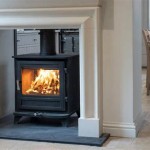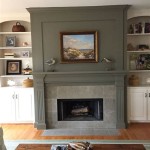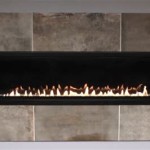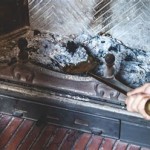Fireplace Mosaic Tile Surrounds: Enhancing Your Hearth with Art and Style
A fireplace serves as a focal point in many homes, providing warmth, ambiance, and a gathering place for family and friends. While the fireplace itself is often the primary attraction, the surrounding area offers a canvas for creative expression. A fireplace mosaic tile surround presents an opportunity to elevate the hearth from a functional necessity to a stunning work of art.
Mosaic tiles, with their inherent versatility and visual appeal, are an excellent choice for fireplace surrounds. These small pieces of glass, stone, ceramic, or other materials can be arranged in intricate patterns, vibrant color schemes, and custom designs, adding a unique character to any living space. The careful selection and artful application of mosaic tiles can transform a standard fireplace into a captivating architectural feature.
This article explores the various aspects of fireplace mosaic tile surrounds, examining the benefits, design considerations, installation processes, and maintenance requirements. It aims to provide comprehensive information for homeowners and design professionals seeking to incorporate mosaic tile into their fireplace design.
Aesthetic and Design Considerations
The aesthetic impact of a fireplace mosaic tile surround is significant. The sheer variety of mosaic tile options allows for unparalleled customization, enabling the creation of a surround that perfectly complements the existing décor of the room. Color, texture, pattern, and size all play crucial roles in achieving the desired visual effect.
Color palettes are a fundamental consideration. Warm tones, such as reds, oranges, and browns, evoke a sense of comfort and coziness, enhancing the feeling of warmth associated with a fireplace. Cool tones, like blues, greens, and grays, offer a more contemporary and tranquil aesthetic. Neutral colors, such as whites, beiges, and creams, provide a versatile backdrop that allows other elements in the room to take center stage. The choice of grout color also impacts the overall appearance, with contrasting grout accentuating the individual tiles and blending grout creating a more seamless look.
Texture adds another dimension to the design. Mosaic tiles are available in a range of textures, from smooth and polished to rough and natural. Textured tiles can create visual interest and depth, adding tactile appeal to the fireplace surround. Combining different textures within a single design can further enhance the visual complexity and create a truly unique focal point.
Patterns and designs offer limitless possibilities. Simple geometric patterns, such as grids, stripes, and chevrons, are classic and timeless choices. More intricate patterns, such as floral motifs, arabesques, and abstract designs, can add a touch of sophistication and artistry. Custom mosaic designs, created from hand-cut tiles or digitally printed images, allow for complete personalization and the creation of a truly one-of-a-kind fireplace surround.
The size of the mosaic tiles also influences the overall aesthetic. Smaller tiles create a more intricate and detailed look, while larger tiles offer a bolder and more modern feel. Mixing different tile sizes within a single design can add visual interest and complexity.
Finally, the architectural style of the home should be taken into consideration. A rustic cabin might benefit from natural stone mosaic tiles with earthy tones, while a modern loft might be better suited to sleek glass mosaic tiles with minimalist patterns.
Material Selection and Performance
The choice of materials for a fireplace mosaic tile surround is crucial for both aesthetic appeal and functional performance. Different materials offer distinct advantages in terms of durability, heat resistance, maintenance, and cost.
Glass mosaic tiles are a popular choice for their vibrant colors, reflective surfaces, and resistance to staining. They are easy to clean and maintain, making them a practical option for a fireplace surround. However, some types of glass may be susceptible to cracking under extreme temperature fluctuations. Tempered glass mosaic tiles are specifically designed to withstand higher temperatures and are a more suitable option for use near a fireplace.
Ceramic and porcelain mosaic tiles are durable, heat-resistant, and relatively inexpensive. They are available in a wide range of colors, patterns, and textures, making them a versatile choice for a variety of design styles. Porcelain tiles are denser and more resistant to moisture than ceramic tiles, making them a better option for areas that are exposed to water or humidity.
Stone mosaic tiles offer a natural and rustic aesthetic. Options such as slate, granite, marble, and travertine provide unique textures and color variations. Stone tiles are durable and heat-resistant, but they can be more porous than glass or ceramic tiles and may require sealing to prevent staining. The natural variations in color and texture inherent in stone can add character and depth to the fireplace surround.
Metal mosaic tiles, such as stainless steel, copper, and brass, offer a modern and industrial aesthetic. They are durable and heat-resistant, but they can be more expensive than other types of mosaic tiles. Metal tiles may also require special cleaning and maintenance to prevent tarnishing.
When selecting materials, it is essential to consider the proximity of the tiles to the fireplace opening. Tiles that are located closer to the heat source should be made of materials that are specifically designed to withstand high temperatures. Heat-resistant mortars and grouts should also be used to ensure the longevity and performance of the installation.
Installation Process and Best Practices
The installation of a fireplace mosaic tile surround requires careful planning, attention to detail, and the use of appropriate tools and materials. Proper installation is essential to ensure the longevity, safety, and aesthetic appeal of the finished product.
The first step is to prepare the surface to be tiled. This involves cleaning the existing surface to remove any dirt, dust, grease, or loose paint. If the surface is uneven, it should be leveled with a patching compound or self-leveling mortar. A cement backer board is often recommended as a substrate for tiling, providing a stable and water-resistant surface.
Next, a thin-set mortar is applied to the backer board using a notched trowel. The type of mortar used should be specifically designed for use with the chosen mosaic tile material and the high temperatures surrounding a fireplace. The mortar should be applied evenly and in small sections to prevent it from drying out before the tiles are set.
The mosaic tiles are then carefully pressed into the mortar, ensuring that they are properly aligned and evenly spaced. Spacers can be used to maintain consistent grout lines. It is important to periodically check the flatness of the tile surface with a level.
Once the mortar has dried, the grout is applied to fill the spaces between the tiles. The grout should be carefully worked into the grout lines using a grout float. Excess grout should be removed with a damp sponge. The type of grout used should also be heat-resistant and appropriate for the chosen tile material.
After the grout has cured, it should be sealed to protect it from staining and moisture. A grout sealant is applied according to the manufacturer's instructions. The tiles themselves can also be sealed, particularly if they are made of porous materials such as natural stone.
Safety precautions should be taken during the installation process. Wear safety glasses and gloves to protect your eyes and hands from dust and chemicals. Ensure adequate ventilation when working with mortars, grouts, and sealants.
For complex mosaic designs or when working with delicate materials, it is often advisable to hire a professional tile installer. A professional installer will have the experience and expertise to ensure a flawless and long-lasting installation.
Proper maintenance is essential to keep the fireplace mosaic tile surround looking its best. Regular cleaning with a mild detergent and water will help prevent the buildup of dirt and grime. Avoid using abrasive cleaners or harsh chemicals, as these can damage the tile surface. Inspect the grout lines periodically for cracks or damage and repair them as needed. Sealing the grout regularly will help prevent staining and moisture damage.

Triangolo Mosaic Fireplace Surround Surrounds Tile

Giving Your Fireplace An Ultimate Facelift With Mosaic Art

Giving Your Fireplace An Ultimate Facelift With Mosaic Art

14 Fresh Designs For Tiled Fireplaces Bob Vila

Magnificent Fireplace Mosaic Designs

Giving Your Fireplace An Ultimate Facelift With Mosaic Art

14 Fresh Designs For Tiled Fireplaces Bob Vila

Custom Installations Christopher Brody

14 Fresh Designs For Tiled Fireplaces Bob Vila

Cau Blue Square Ceramic Mosaic Tile With Free On Qualifying Orders
Related Posts








